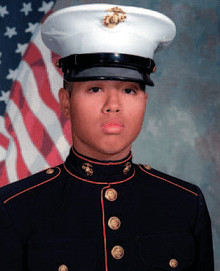Jesse Aliganga
Jesse Nathanael "Nathan" Aliganga (October 17, 1976 – August 7, 1998) was a United States Marine Corps security guard who was killed in the 1998 U.S. embassy bombings in Nairobi, Kenya. He was the only U.S. Marine killed in the bombings.
Jesse Nathanael Aliganga | |
|---|---|
 Aliganga in 1995 | |
| Birth name | Jesse Nathanael Aliganga |
| Nickname(s) | "Nathan" |
| Born | October 17, 1976[1][2] Oakland, California, U.S. |
| Died | August 7, 1998 (aged 21) Nairobi, Kenya[3] |
| Buried | |
| Allegiance | |
| Service/ | |
| Years of service | 1995-1998 |
| Rank | |
| Unit | Marine Security Guard Battalion |
| Battles/wars | 1998 U.S. embassy bombings † |
| Awards | |
Aliganga was working at the American embassy in Nairobi, Kenya. On August 7, 1998, at the age of 21, Aliganga was killed by a car-bomb explosion, along with eleven fellow Americans, in a suicide bomb attack. Aliganga was the only U.S. Marine who was killed in the attack in Kenya. This was part of a simultaneous suicide bomb attack in which car bombs were exploded at U.S. embassies in Tanzania and Kenya, killing 224 people and wounding over 4,000. The attack was later determined to be conducted by the al-Qaeda network and Osama bin Laden.
Early life and education
Aliganga, of Philippine descent,[5] was born on October 17, 1976, in Oakland, California[1][2] and attended high school in Tallahassee, Florida, graduating in 1994.[6][7]
Career
In January 1995, Aliganga enlisted in the U.S. Marine Corps. Aliganga attended U.S. Marine Corps recruit training at the Marine Corps Recruit Depot Parris Island, in South Carolina. Thereafter, he trained as a communication specialist at the Marine Air Ground Combat Center in 29 Palms, California and at Keesler Air Force Base in Biloxi, Mississippi. After training, he was stationed with the 3rd Marine Division at the Marine Corps Base in Okinawa, Japan, followed by service with the 1st Force Service Support Group, 1st Landing Support Battalion, H&S Company, Communications Platoon at Camp Pendleton.
In early January 1998, based on recommendations from his superiors, Aliganga was sent to the elite Marine Security Guard School, in MCB Quantico, Virginia. Upon completing the rigorous training, Aliganga requested the American embassy in Nairobi, Kenya. In late February 1998, his request was approved and he was assigned to one tour of special duty at the U.S. embassy in Kenya, where he worked until his death on August 7, 1998, when the embassy was attacked by Islamist terrorists.
Legacy
Aliganga was posthumously awarded the Purple Heart and is buried at Arlington National Cemetery.[8]
References
- "Aliganga, Jesse Nathanael". Dixie Stones. Retrieved August 8, 2013.
- "Jesse Nathanael Aliganga". Find A Grave. Retrieved August 8, 2013.
- U.S. Navy (28 February 2008). "Casualties: U.S. Navy and Marine Corps Personnel Killed and Wounded in Wars, Conflicts, Terrorist Acts, and Other Hostile Incidents". Naval Historical Center. Department of the Navy. Archived from the original on 5 June 2007. Retrieved 2 November 2009.
- "Jesse Nathanael Aliganga". Arlington National Cemetery. 2 December 2006. Retrieved November 2, 2009.
- "Fil-Am hero guard killed in Nairobi". Filipino Reporter. 20 August 1998. Archived from the original on 2 November 2012. Retrieved 2 November 2009.
- Waldman, Amy (August 10, 1998). "Bombings in East Africa: The American Dead; Their Quiet Lives, Rendered Stark and Bold by the Manner of Their Deaths". New York Times. pp. Page A7. Retrieved 2007-03-25.
- Kallestad, Brent (8 August 1998). "Families Mourn Kenya Bomb Victims". Associated Press. Retrieved 11 December 2019.
- Fortitudine: Newsletter of the Marine Corps Historical Program. History and Museums Division, U.S. Marine Corps. 1999. p. 105.
Further reading
- Aita, Judy (March 7, 2001). "Victims Retell Horrors of Nairobi Embassy Bombing in Court". International Information Programs. U.S. Department of State. Archived from the original on March 17, 2007. Retrieved 2007-03-25.
External links
- "Historical Profile—Sgt Jesse Aliganga". Marine Embassy Guard Association. Archived from the original on 2006-11-24. Retrieved 2006-12-12.